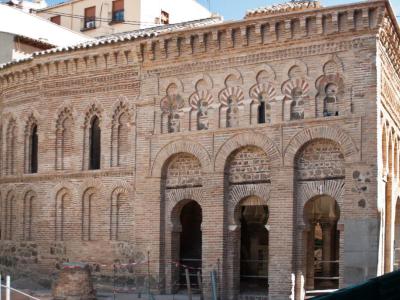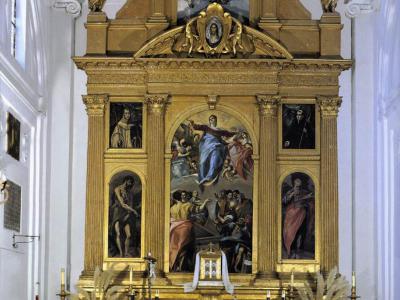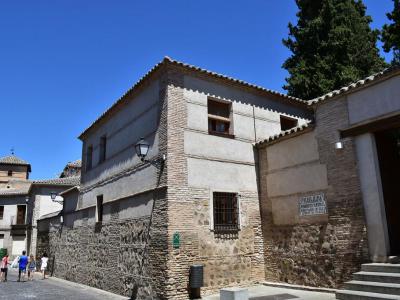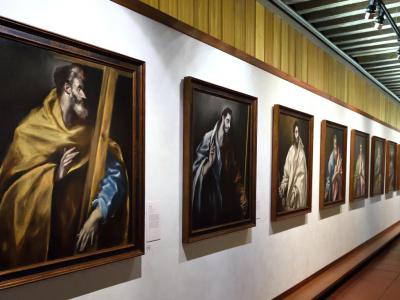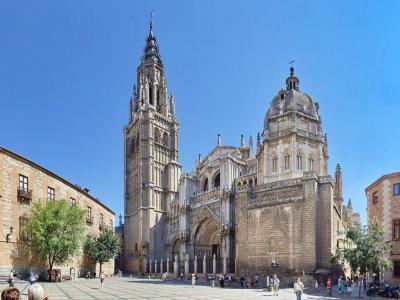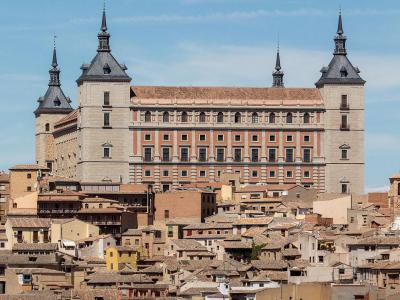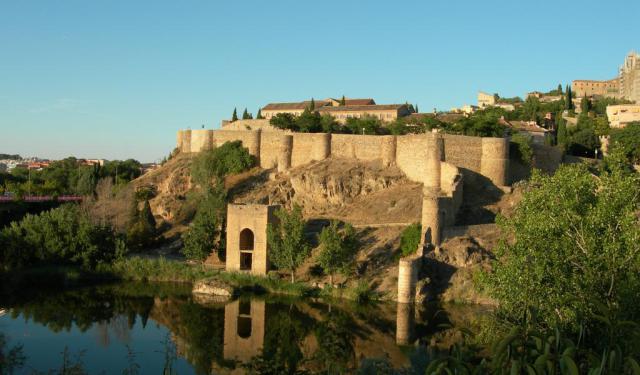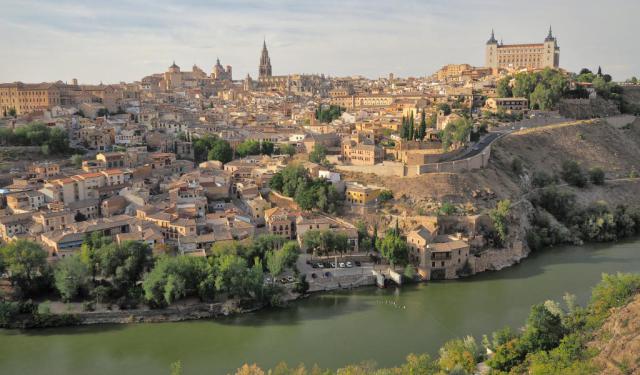
Toledo Introduction Walking Tour (Self Guided), Toledo
Located on the banks of the Tagus River in Spain, Toledo is called the "City of the Three Cultures." The cultures would be Christianity, Islam, and Judaism. They didn't always get along, but each has left its mark. Romans visited the area as early as 193 BC. Roman historian Livy referred to the city as "a small city, but fortified by location."
In 546, the early Germanic people, Visigoths, took over the city. In 711, the Moors' army captured Toledo and started Islamic rule. In 1085, Alfonso VI of Leon re-captured Toledo for Christians, and the Islamic era in Spain began its decline.
Toledo is undoubtedly the best-preserved UNESCO World Heritage Site in Spain. The Old City has kept its medieval layout of narrow winding streets and byways, walls, palaces, and above all, the formidable Fortress of Alcazar. Besieged by Republican forces in the 1936 Civil War, today, the fortress is the home of the Regional Library.
The grandiose Toledo Cathedral is a five-minute walk from the Fortress of Alcazar. It houses the Monarchs' Chapel and the Gold Monstrance of Arfe. On the 15th of August, the feast day of the Virgin of Sagario, pilgrims drink miraculous water from pots in front of the Cathedral.
The Ayuntamiento Square has the Episcopal Palace and the Town Hall. The Church of San Ildefonso is said to be on the highest point of the city, affording spectacular views.
See the old Jewish quarter, the Transito Synagogue, and the Sephardic Museum. The Church of Santo Tome is home to El Greco's masterpiece, "The Burial of the Count of Orgaz." The city has a lot of El Greco's incomparable paintings.
Mosques, cathedrals, synagogues, walls, a really great fortress, museums, bars, food, and, yes, wine. After all that, head to the lofty Valley Lookout (Mirador del Valle), sip an espresso and watch the sun setting on the city of El Greco.
In 546, the early Germanic people, Visigoths, took over the city. In 711, the Moors' army captured Toledo and started Islamic rule. In 1085, Alfonso VI of Leon re-captured Toledo for Christians, and the Islamic era in Spain began its decline.
Toledo is undoubtedly the best-preserved UNESCO World Heritage Site in Spain. The Old City has kept its medieval layout of narrow winding streets and byways, walls, palaces, and above all, the formidable Fortress of Alcazar. Besieged by Republican forces in the 1936 Civil War, today, the fortress is the home of the Regional Library.
The grandiose Toledo Cathedral is a five-minute walk from the Fortress of Alcazar. It houses the Monarchs' Chapel and the Gold Monstrance of Arfe. On the 15th of August, the feast day of the Virgin of Sagario, pilgrims drink miraculous water from pots in front of the Cathedral.
The Ayuntamiento Square has the Episcopal Palace and the Town Hall. The Church of San Ildefonso is said to be on the highest point of the city, affording spectacular views.
See the old Jewish quarter, the Transito Synagogue, and the Sephardic Museum. The Church of Santo Tome is home to El Greco's masterpiece, "The Burial of the Count of Orgaz." The city has a lot of El Greco's incomparable paintings.
Mosques, cathedrals, synagogues, walls, a really great fortress, museums, bars, food, and, yes, wine. After all that, head to the lofty Valley Lookout (Mirador del Valle), sip an espresso and watch the sun setting on the city of El Greco.
How it works: Download the app "GPSmyCity: Walks in 1K+ Cities" from Apple App Store or Google Play Store to your mobile phone or tablet. The app turns your mobile device into a personal tour guide and its built-in GPS navigation functions guide you from one tour stop to next. The app works offline, so no data plan is needed when traveling abroad.
Toledo Introduction Walking Tour Map
Guide Name: Toledo Introduction Walking Tour
Guide Location: Spain » Toledo (See other walking tours in Toledo)
Guide Type: Self-guided Walking Tour (Sightseeing)
# of Attractions: 12
Tour Duration: 2 Hour(s)
Travel Distance: 3.2 Km or 2 Miles
Author: nataly
Sight(s) Featured in This Guide:
Guide Location: Spain » Toledo (See other walking tours in Toledo)
Guide Type: Self-guided Walking Tour (Sightseeing)
# of Attractions: 12
Tour Duration: 2 Hour(s)
Travel Distance: 3.2 Km or 2 Miles
Author: nataly
Sight(s) Featured in This Guide:
- Plaza de Zocodover (Zocodover Square)
- Puerta del Sol (Sun Gate)
- Ermita "Mezquita" del Cristo de la Luz (Mosque of Cristo de la Luz)
- Monasterio de Santo Domingo el Antiguo (Monastery of Saint Dominic the Old)
- Monasterio de San Juan de los Reyes (Monastery of Saint John of the Monarchs)
- Sinagoga de Santa Maria La Blanca (Synagogue of Saint Mary the White)
- Synagogue of El Transito and Sephardic Museum
- Museo del Greco (El Greco Museum)
- Iglesia de Santo Tome (Church of St. Tom)
- Ayuntamiento de Toledo (Toledo City Hall)
- Toledo Cathedral and Monstrance of Arfe
- Alcazar Fortress
1) Plaza de Zocodover (Zocodover Square)
"Zocodover" is derived from the Arabic "suq adawabb," meaning "Market of load-carrying animals." It was an animal market. At times it was a bull ring. It was always a venue for traditional festivals and occasionally a place for "cucanas." This last event featured throwing pinatas (decorated vessels) of sweets and dead rats. The winners got the rats.
Zocodover Square has been the town's nerve center since the Middle Ages. Besides local parties, the square has harbored the dreadful "autos-da-fe" (burning of a heretic) of the Inquisition and public executions. These days, Zocodover Square serves as a popular place of meeting for locals and the thousands of tourists who gather here each year.
The rocky terrain of Toledo is crisscrossed with narrow, steep, twisted streets and byways centering on Zocodover Square. The square is very lively. There is no dearth of bars, restaurants, and shops. It has been designated a weekly market for hundreds of years. The market opens on Tuesdays at the Merchan's Promenade (Paseo de Merchan) or Vega Park (Parque de la Vega), called by locals.
Zocodover Square has been the town's nerve center since the Middle Ages. Besides local parties, the square has harbored the dreadful "autos-da-fe" (burning of a heretic) of the Inquisition and public executions. These days, Zocodover Square serves as a popular place of meeting for locals and the thousands of tourists who gather here each year.
The rocky terrain of Toledo is crisscrossed with narrow, steep, twisted streets and byways centering on Zocodover Square. The square is very lively. There is no dearth of bars, restaurants, and shops. It has been designated a weekly market for hundreds of years. The market opens on Tuesdays at the Merchan's Promenade (Paseo de Merchan) or Vega Park (Parque de la Vega), called by locals.
2) Puerta del Sol (Sun Gate)
Even before the Romans, the city of "Toletum" was known to be small but well fortified by its location. The Romans improved the city's defensive ability with secure walls and a series of portals. The Moors further added to the town's security. To this day, the city can only be accessed through its many gateways.
The Sun Gate (Puerta del Sol) was built by the Knights Hospitalers ( the medieval and early modern Catholic military order) in the 14th century. The gate is located on the steepest hillside of the town. There was not much need for walls here. The high cliff face overlooks the Tagus River. If the climb is too stiff, a ride on the Zocoloco Touristic Train will take one there.
The Hospitalers founded Saint John's Hospital in Jerusalem. They founded and managed other hospitals in the Holy Land and throughout Europe. There is a bas-relief medallion of the Sun over the Moorish-style arch. The arch medallion also depicts the ordination of Saint Ildephonsus, the patron saint of Toledo.
The Sun Gate (Puerta del Sol) was built by the Knights Hospitalers ( the medieval and early modern Catholic military order) in the 14th century. The gate is located on the steepest hillside of the town. There was not much need for walls here. The high cliff face overlooks the Tagus River. If the climb is too stiff, a ride on the Zocoloco Touristic Train will take one there.
The Hospitalers founded Saint John's Hospital in Jerusalem. They founded and managed other hospitals in the Holy Land and throughout Europe. There is a bas-relief medallion of the Sun over the Moorish-style arch. The arch medallion also depicts the ordination of Saint Ildephonsus, the patron saint of Toledo.
3) Ermita "Mezquita" del Cristo de la Luz (Mosque of Cristo de la Luz)
The Catholic Chapel of Cristo de la Luz was built as a mosque in 999 AD. It was one of the ten mosques created in Toledo during the Moorish era. Before the Catholics retook the city, the building was called Bad-al-Mardum Mosque (Mezquita Bad-al-Mardum,) after the nearby gate was taken over by the Sun Gate (Puerta del Sol). "Mardum" means "blocked up."
The founder and patron of the mosque was Ahmad Ibn Hadidi. The builder was Musa Ibn Ali. The engraving, in Kufic script, declares this to be so. The inscription further claims Ahmad Ibn Hadidi had the mosque built hoping for Paradise as a reward. The condition of the building is in the same state now as when it was built.
The religious edifice, constructed of bricks and stones, is a small square building, 26 feet by 26 feet. It has a semicircular apse on the east side. Columns with capitals divide the interior into nine sections. The vaults of the bays are supported by horseshoe arches. Each vault is ribbed with its unique design.
The cupola of the high central vault has ribs in the form of a star. Some of the columns and capitals are fashioned from spoils of Visigothic works. One facade has brickwork similar to that of the Cathedral-Mosque of Cordoba. The east wall is the Mecca-facing qiblah wall holding the mihrab, a niche of worship.
Three facades have individually decorated arcades. The main entrance wall has a lobed arch and two horseshoe arches, one wider than the other. A small garden with a fountain in the center adjoins the building.
The founder and patron of the mosque was Ahmad Ibn Hadidi. The builder was Musa Ibn Ali. The engraving, in Kufic script, declares this to be so. The inscription further claims Ahmad Ibn Hadidi had the mosque built hoping for Paradise as a reward. The condition of the building is in the same state now as when it was built.
The religious edifice, constructed of bricks and stones, is a small square building, 26 feet by 26 feet. It has a semicircular apse on the east side. Columns with capitals divide the interior into nine sections. The vaults of the bays are supported by horseshoe arches. Each vault is ribbed with its unique design.
The cupola of the high central vault has ribs in the form of a star. Some of the columns and capitals are fashioned from spoils of Visigothic works. One facade has brickwork similar to that of the Cathedral-Mosque of Cordoba. The east wall is the Mecca-facing qiblah wall holding the mihrab, a niche of worship.
Three facades have individually decorated arcades. The main entrance wall has a lobed arch and two horseshoe arches, one wider than the other. A small garden with a fountain in the center adjoins the building.
4) Monasterio de Santo Domingo el Antiguo (Monastery of Saint Dominic the Old)
Monastery of Saint Dominic the Old is a Cistercian convent founded in the 6th century by King Alfonso VI after his reconquest of the city in 1085.
In July 1577, when El Greco came up from Rome to sign contracts for a group of paintings for the convent, he saw a refurbished Mudejar structure. The walls had Ionic pilasters; there was a dome, supported by pendentives, two courtyards, and a brick cloister. It was not impressive. He set to work.
By 1579 he had completed a total of nine paintings for Santo Domingo, including the "Disrobing of Christ," "The Trinity," and "The Assumption of the Virgin." Seven canvases were for the high altar and two for the side altars.
At the present day, the paintings remaining in the monastery are Saint Bernard, Saint Benedict, John the Baptist, John the Evangelist, The Holy Trinity, the Adoration of the Shepherds, the Assumption of the Virgin, and Resurrection. The Disrobing of Christ is now at Toledo Cathedral.
El Greco settled in Toledo and produced most of his work there. He had a son, Jorge, who also was a painter. El Greco died in 1614, and his body lies in the crypt beneath the church. The Monastery museum houses other works of art, but none, like those of El Greco.
In July 1577, when El Greco came up from Rome to sign contracts for a group of paintings for the convent, he saw a refurbished Mudejar structure. The walls had Ionic pilasters; there was a dome, supported by pendentives, two courtyards, and a brick cloister. It was not impressive. He set to work.
By 1579 he had completed a total of nine paintings for Santo Domingo, including the "Disrobing of Christ," "The Trinity," and "The Assumption of the Virgin." Seven canvases were for the high altar and two for the side altars.
At the present day, the paintings remaining in the monastery are Saint Bernard, Saint Benedict, John the Baptist, John the Evangelist, The Holy Trinity, the Adoration of the Shepherds, the Assumption of the Virgin, and Resurrection. The Disrobing of Christ is now at Toledo Cathedral.
El Greco settled in Toledo and produced most of his work there. He had a son, Jorge, who also was a painter. El Greco died in 1614, and his body lies in the crypt beneath the church. The Monastery museum houses other works of art, but none, like those of El Greco.
5) Monasterio de San Juan de los Reyes (Monastery of Saint John of the Monarchs) (must see)
King Ferdinand II of Aragon and Queen Isabella of Castile were married in 1469. Isabella was 18. Ferdinand was one year younger. They were married in the city of Valladolid. It is said the unification of Spain began with this marriage. They became known as the "Catholic Monarchs" for their defense of the Church.
The Monastery of Saint John of the Monarchs is a Franciscan monastery built by the Catholic Monarchs between 1477-1504. Ferdinand and Isabella wished to commemorate the birth of their son, Prince John, and their victory over Afonso V of Portugal at the Battle of Toro in 1476.
The victory of Toro was ambiguous. One wing of the army of Portugal collapsed while the other prevailed. The victory was celebrated by both parties. A political victory for the Catholic Monarchs assured them the throne and the unification of Spain.
Initially, the monastery was named Saint John of the Monarchs (San Juan de la Reyna), built as the future mausoleum of the Catholic Monarchs. The plans changed in 1492 with the reconquest of Granada.
The Monastery of Saint John of the Monarchs, designed by architect Juan Guas in 1477, was dedicated for use by the Franciscan friars. In 1808, the building was severely damaged by Napoleonic troops during their occupation of Toledo. Restoration began in 1883 but was not completed until 1967.
The monastery is an example of the Isabelline Gothic style with Spanish and Flemish influences. Its church is in the form of a Latin cross. It has short arms and an elongated nave. There are side chapels between domed arches, three on each side of the nave and two under the choir. The chancel has a mid-16th century altar made by sculptor Felipe Bigarny and paintings of the Passion and the Resurrection by Francisco de Comontes.
The ground floor ceiling has German cross vaults with figures of saints, animals, and plants created by sculptor Cecilio Bejar in the 20th century. The upper cloisters of 1526 have a Larchwood ceiling painted with the arms of the Catholic Monarchs and the alleged prenuptial motto of Ferdinand and Isabella: "They amount to the same, the same they amount to."
The Monastery of Saint John of the Monarchs is a Franciscan monastery built by the Catholic Monarchs between 1477-1504. Ferdinand and Isabella wished to commemorate the birth of their son, Prince John, and their victory over Afonso V of Portugal at the Battle of Toro in 1476.
The victory of Toro was ambiguous. One wing of the army of Portugal collapsed while the other prevailed. The victory was celebrated by both parties. A political victory for the Catholic Monarchs assured them the throne and the unification of Spain.
Initially, the monastery was named Saint John of the Monarchs (San Juan de la Reyna), built as the future mausoleum of the Catholic Monarchs. The plans changed in 1492 with the reconquest of Granada.
The Monastery of Saint John of the Monarchs, designed by architect Juan Guas in 1477, was dedicated for use by the Franciscan friars. In 1808, the building was severely damaged by Napoleonic troops during their occupation of Toledo. Restoration began in 1883 but was not completed until 1967.
The monastery is an example of the Isabelline Gothic style with Spanish and Flemish influences. Its church is in the form of a Latin cross. It has short arms and an elongated nave. There are side chapels between domed arches, three on each side of the nave and two under the choir. The chancel has a mid-16th century altar made by sculptor Felipe Bigarny and paintings of the Passion and the Resurrection by Francisco de Comontes.
The ground floor ceiling has German cross vaults with figures of saints, animals, and plants created by sculptor Cecilio Bejar in the 20th century. The upper cloisters of 1526 have a Larchwood ceiling painted with the arms of the Catholic Monarchs and the alleged prenuptial motto of Ferdinand and Isabella: "They amount to the same, the same they amount to."
6) Sinagoga de Santa Maria La Blanca (Synagogue of Saint Mary the White)
The Synagogue of Saint Mary the White, built in the 12th or early 13th century, is considered the oldest synagogue in Europe. It is in the old Jewish quarter, between the Monastery of Saint John of the Monarchs and the Synagogue of El Transito. It is one of three preserved synagogues in Spain, built by Jews in the Mudejar style.
The exact origin of the Sinagoga is unclear. Its Almohad layout similarities indicate it may have been erected over the site of a preexisting mosque. The sponsor of the original synagogue is believed to be Joseph ben Meir ben Shoshan, son of the finance minister of King Alfonso VIII of Castile.
In the Massacre of 1391, also known as the Pogroms (the act of antisemitism and violence against Jews in Spain), the Sinagoga was sacked and taken over by the Catholic Church. The new church was given to the religious-military Order of Calatrava. By 1556 three small apses were added to be chapels. They were in the Renaissance style and are credited to architect and sculptor Alonso de Covarrubias.
The interior arcades of horseshoe arches are held up by a forest of octagonal piers. The capitals are Mudéjar, Corinthian, and Byzantine in style. A scallop-shell arch in the center marks the location of the Torah ark. A courtyard surrounds the synagogue. There is a ritual bath, a Rabbi's residence, and a study hall.
The exact origin of the Sinagoga is unclear. Its Almohad layout similarities indicate it may have been erected over the site of a preexisting mosque. The sponsor of the original synagogue is believed to be Joseph ben Meir ben Shoshan, son of the finance minister of King Alfonso VIII of Castile.
In the Massacre of 1391, also known as the Pogroms (the act of antisemitism and violence against Jews in Spain), the Sinagoga was sacked and taken over by the Catholic Church. The new church was given to the religious-military Order of Calatrava. By 1556 three small apses were added to be chapels. They were in the Renaissance style and are credited to architect and sculptor Alonso de Covarrubias.
The interior arcades of horseshoe arches are held up by a forest of octagonal piers. The capitals are Mudéjar, Corinthian, and Byzantine in style. A scallop-shell arch in the center marks the location of the Torah ark. A courtyard surrounds the synagogue. There is a ritual bath, a Rabbi's residence, and a study hall.
7) Synagogue of El Transito and Sephardic Museum
The Synagogue of El Transito is historically a synagogue, church, and Sephardic museum. It was designed by architect and master mason Don Meir Abdeil and built in 1357 as an annex to the palace of Samuel ha-Levi Abulafia. Samuel was treasurer to King Peter of Castile. With the expulsion of Jews in 1492, the synagogue became a church.
The synagogue was given, as a church, in 1492, to the Order of Calatrava by Ferdinand and Isabella. The term "El Transito" refers to the Assumption of the Virgin Mary. Used as a barracks in the Napoleonic Wars, the building was declared a National Monument in 1877. It became a Sephardic Museum in 1910.
The prayer hall measures 76 feet by 30 feet. The ceiling is almost 40 feet high. It has multi-colored Madrid-style stucco work, multi-leaved arches, and a formidable wood Mudéjar ceiling. Arabic, Jewish, and Christian inscriptions abound. The prayer hall is lined with carved Larchwood frames with ivory inlay. The floor is covered in mosaics.
The starry sky on the frieze of the synagogue represents Heaven. The floor, covered in vegetal designs, is the Earth. In between is Jerusalem, the go-between Heaven and Earth. The intention is that the observer could read the art and architecture like a book, as seen in Arab palaces and mosques in Andalucia.
The synagogue was given, as a church, in 1492, to the Order of Calatrava by Ferdinand and Isabella. The term "El Transito" refers to the Assumption of the Virgin Mary. Used as a barracks in the Napoleonic Wars, the building was declared a National Monument in 1877. It became a Sephardic Museum in 1910.
The prayer hall measures 76 feet by 30 feet. The ceiling is almost 40 feet high. It has multi-colored Madrid-style stucco work, multi-leaved arches, and a formidable wood Mudéjar ceiling. Arabic, Jewish, and Christian inscriptions abound. The prayer hall is lined with carved Larchwood frames with ivory inlay. The floor is covered in mosaics.
The starry sky on the frieze of the synagogue represents Heaven. The floor, covered in vegetal designs, is the Earth. In between is Jerusalem, the go-between Heaven and Earth. The intention is that the observer could read the art and architecture like a book, as seen in Arab palaces and mosques in Andalucia.
8) Museo del Greco (El Greco Museum) (must see)
Don Benigno de la Vega-Incian y Flaques, Marquis of Vega-Incian, who died in 1942, was one of the most important patrons of the arts of Spain. He developed several cultural projects serving a public purpose, such as the El Greco Museum (Museo del Greco in Toledo) in 1911, Cervantes' House (the Casas de Cervantes) in Valladolid in 1915, and the Museum of Romanticism (Museo del Romanticismo) in Madrid (1924).
Early in the 20th century, don Benigno bought some houses in the old Jewish section of Toledo. The houses were restored by architect Eladio Laredo and made into a reconstruction of the House of El Greco. Don Benigno created a museum with a historical atmosphere. He lived in the house until he died. It was then bequeathed to the state.
The museum enabled the gathering of works by El Greco scattered throughout Toledo. In 1925 the museum added new rooms to include Spanish paintings of the 17th century. The El Greco Museum is housed in a former hospital with Moorish ceilings. There is 17th-century furniture and pottery from Talavera de la Reina.
The collection features 13 paintings of Christ and his disciples created by El Greco between 1610 and 1614. It was a single project featuring Christ and the apostles, except that Judas is replaced by St Paul. All these works are oil on canvas measuring 97 X 77 cm. El Greco was a Mannerist painter. His real name was Domenikos Theotokopoulos.
Early in the 20th century, don Benigno bought some houses in the old Jewish section of Toledo. The houses were restored by architect Eladio Laredo and made into a reconstruction of the House of El Greco. Don Benigno created a museum with a historical atmosphere. He lived in the house until he died. It was then bequeathed to the state.
The museum enabled the gathering of works by El Greco scattered throughout Toledo. In 1925 the museum added new rooms to include Spanish paintings of the 17th century. The El Greco Museum is housed in a former hospital with Moorish ceilings. There is 17th-century furniture and pottery from Talavera de la Reina.
The collection features 13 paintings of Christ and his disciples created by El Greco between 1610 and 1614. It was a single project featuring Christ and the apostles, except that Judas is replaced by St Paul. All these works are oil on canvas measuring 97 X 77 cm. El Greco was a Mannerist painter. His real name was Domenikos Theotokopoulos.
9) Iglesia de Santo Tome (Church of St. Tom) (must see)
The Church of Saint Tom, in the historical center of Toledo, was founded by King Alfonso VI of Leon after his siege of the city in 1085. Like many other mosques in the city, it was undamaged at the time. It was easily converted to use as a church. By the 14th century, the building had fallen into neglect and needed a total rebuild.
The church was rebuilt in charge of Gonzalo Ruiz de Toledo, Lord of Orgaz. At the time of his death in 1323, he was mayor of Toledo. He was honored as a generous donor to religious institutions. He restored and rebuilt the edifice and changed the minaret into a bell tower.
The church has three naves in a cruciform layout covered by a barrel vault and a polygonal apse. The largest chapel is a mixture of styles, including Mudéjar and Gothic. The central dome was raised in the shape of the eight-pointed Islamic star, Rub el Hizb. Near the main altar is the door to the bell tower staircase.
The church's chapels have two baroque reredoses (ornamental screens covering the wall at the back of an altar) and a 16th-century baptismal font. The main 19th-century replacement chapel holds the painting "The unbelief of Saint Thomas" by 18th-century artist Vicente Lopez Portana.
Gonzalo Ruiz de Toledo is buried in the Conception Chapel at the foot of the nave on the side of the Epistle. In this land of miracles, El Greco's painting of 1584 portrays a real top-flight Heavenly vision. It is "The Burial of the Count of Orgaz." El Greco's painting is the crowning centerpiece of the Church of Saint Tom.
Saint Stephen and Saint Augustine descend to assist at the funeral before dazzled eyewitnesses. Everyone is included in the massive painting: the artist himself and his son, Jorge, Philip II, Christ, Madonna, and crowds of nobles. The Count of Orgaz is received in Heaven as his armored body is being lowered by the saints into its grave.
The church was rebuilt in charge of Gonzalo Ruiz de Toledo, Lord of Orgaz. At the time of his death in 1323, he was mayor of Toledo. He was honored as a generous donor to religious institutions. He restored and rebuilt the edifice and changed the minaret into a bell tower.
The church has three naves in a cruciform layout covered by a barrel vault and a polygonal apse. The largest chapel is a mixture of styles, including Mudéjar and Gothic. The central dome was raised in the shape of the eight-pointed Islamic star, Rub el Hizb. Near the main altar is the door to the bell tower staircase.
The church's chapels have two baroque reredoses (ornamental screens covering the wall at the back of an altar) and a 16th-century baptismal font. The main 19th-century replacement chapel holds the painting "The unbelief of Saint Thomas" by 18th-century artist Vicente Lopez Portana.
Gonzalo Ruiz de Toledo is buried in the Conception Chapel at the foot of the nave on the side of the Epistle. In this land of miracles, El Greco's painting of 1584 portrays a real top-flight Heavenly vision. It is "The Burial of the Count of Orgaz." El Greco's painting is the crowning centerpiece of the Church of Saint Tom.
Saint Stephen and Saint Augustine descend to assist at the funeral before dazzled eyewitnesses. Everyone is included in the massive painting: the artist himself and his son, Jorge, Philip II, Christ, Madonna, and crowds of nobles. The Count of Orgaz is received in Heaven as his armored body is being lowered by the saints into its grave.
10) Ayuntamiento de Toledo (Toledo City Hall)
Located on modest Town Hall Square (Plaza del Ayuntamiento), the Toledo City Hall construction began in 1575. It was not completed until 1703. Several talented architects and artists contributed to its creation over the years. Alonso de Covarrubias, Nicolas de Vergara, Elder and Younger, Juan de Herrera, Teodoro Ardemans, and El Greco's son, Jorge, all had a hand.
The outstanding feature of the Hall is its Spanish Baroque, Herrerian-style facade bracketed by turrets with spires. Its basic design was made by architect Juan Herrera in 1575. Any severity in the main exterior is his work. Nicolas Vergara (the Elder) and Juan Bautista Monegro did the first floor. Jorge Manuel Theotocópuli, son of El Greco, finished the upper floor.
The Hall shares space on Town Hall Square with the Cathedral of Toledo, the largest Gothic cathedral in Spain. Another neighbor is the Archbishop's Palace. The 25-member City Council and the Toledo Tourist Information Office are located in the City Hall.
The ground floor fills the whole block. It has a central courtyard surrounded by rooms. The main entrance opens to a large reception hall with a Baroque staircase. The upper part of the facade holds a Herrerian-style footbridge ("pasadero") with a balustrade. On the third floor is a balcony with gratings and large rectangular windows.
The outstanding feature of the Hall is its Spanish Baroque, Herrerian-style facade bracketed by turrets with spires. Its basic design was made by architect Juan Herrera in 1575. Any severity in the main exterior is his work. Nicolas Vergara (the Elder) and Juan Bautista Monegro did the first floor. Jorge Manuel Theotocópuli, son of El Greco, finished the upper floor.
The Hall shares space on Town Hall Square with the Cathedral of Toledo, the largest Gothic cathedral in Spain. Another neighbor is the Archbishop's Palace. The 25-member City Council and the Toledo Tourist Information Office are located in the City Hall.
The ground floor fills the whole block. It has a central courtyard surrounded by rooms. The main entrance opens to a large reception hall with a Baroque staircase. The upper part of the facade holds a Herrerian-style footbridge ("pasadero") with a balustrade. On the third floor is a balcony with gratings and large rectangular windows.
11) Toledo Cathedral and Monstrance of Arfe (must see)
Before the Primatial Cathedral of Saint Mary of Toledo, another religious structure was on the same spot. Consecrated in the sixth century, in the time of the Visigothic Kingdom, the church was demolished after the Muslim invasion and replaced by a mosque.
Alfonso VI, King of Leon and Castile, reconquered the city in 1085. In 1087, the mosque was seized and converted into a Christian cathedral. Traces of the mosque remain. The minaret is turned into the bell tower. There is an Islamic column in the chapel of Saint Lucy. Caliphate arches appear in the main chapel.
The main facade fronts the Town Hall Square (Plaza del Ayuntamiento) and the Archbishop's Palace. To the left is the bell tower. On the right is the dome of the Mozarabic chapel. The lower part of the tower is squared. The upper part is octagonal and topped by a spire.
The facade has three portals. The Gate of Forgiveness is in the center. The Gate of the Last Judgement is right of the center. The Gate of Hell is on the left. The center portal has one great arch with six Gothic archivolts. In the tympanum, the Virgin offers a chasuble to Saint Ildephonsus. There are five other portals.
The cathedral has five naves with a transept and ambulatory. The vaults are ribbed. The Gothic retable is sumptuously florid. It rises high, covered with delicate scenes culminating in the Crucifixion. The Baroque altarpiece "El Transparente" by Narciso Tome creates the illusion of ascension to Heaven.
In the Chapel of the Treasure is the precious Monstrance of Arfe, created by the master ironworker Enrique de Arfe in 1524. The Monstrance is in the form of a Gothic temple. It has columns, arches, vaults, and 260 statuettes of angels and saints. Finished in silver, gold, and gilded Larchwood, it sits on a hexagonal base.
It has been the custom to grandly parade the Monstrance, in the procession of Corpus Christi, since 565. Some say its furnishings include gold taken from the New World by Columbus.
Alfonso VI, King of Leon and Castile, reconquered the city in 1085. In 1087, the mosque was seized and converted into a Christian cathedral. Traces of the mosque remain. The minaret is turned into the bell tower. There is an Islamic column in the chapel of Saint Lucy. Caliphate arches appear in the main chapel.
The main facade fronts the Town Hall Square (Plaza del Ayuntamiento) and the Archbishop's Palace. To the left is the bell tower. On the right is the dome of the Mozarabic chapel. The lower part of the tower is squared. The upper part is octagonal and topped by a spire.
The facade has three portals. The Gate of Forgiveness is in the center. The Gate of the Last Judgement is right of the center. The Gate of Hell is on the left. The center portal has one great arch with six Gothic archivolts. In the tympanum, the Virgin offers a chasuble to Saint Ildephonsus. There are five other portals.
The cathedral has five naves with a transept and ambulatory. The vaults are ribbed. The Gothic retable is sumptuously florid. It rises high, covered with delicate scenes culminating in the Crucifixion. The Baroque altarpiece "El Transparente" by Narciso Tome creates the illusion of ascension to Heaven.
In the Chapel of the Treasure is the precious Monstrance of Arfe, created by the master ironworker Enrique de Arfe in 1524. The Monstrance is in the form of a Gothic temple. It has columns, arches, vaults, and 260 statuettes of angels and saints. Finished in silver, gold, and gilded Larchwood, it sits on a hexagonal base.
It has been the custom to grandly parade the Monstrance, in the procession of Corpus Christi, since 565. Some say its furnishings include gold taken from the New World by Columbus.
12) Alcazar Fortress (must see)
Jose Moscardo Ituarte, Military governor of the province of Toledo, was on the phone. It was July 23d, 1936. Moscardo's command post, the Alcazar Fortress, was under siege by Republican forces. He was talking to his son, Luis, a prisoner of the Republicans. The besieging enemy would spare Luis' life if Alcazar surrendered.
"Commend your soul to God." He told his son, "shouting 'Long live Christ, King!' and 'Long live Spain!'" The Alcazar held out, and Luis was killed. The siege ended with the arrival of Nationalist relief forces on September 27th. The merciless Civil War made Alcazar a symbol of Spanish Nationalism. Heavily damaged, the fortress was rebuilt.
"Alcazar" is derived from the Arabic word for castle. Originally a Roman Palace in the 3rd century, it was restored in the 1540s by Charles I and his son, Philip II of Spain. Today it is home to the Castilla-La Mancha Regional Library and the Museum of the Army ("Museo del Ejercito").
The fortress sits firmly on the highest elevation in the city, dominating all around it. Its facades are Renaissance in style. It is rectangular, four-sided, with crenelated defense walls and turreted towers at each corner, according to a preliminary design by Alonso de Covarrubias, subsequently completed by Juan de Herrera.
The fortress is open from 11 am to 5 pm every day.
"Commend your soul to God." He told his son, "shouting 'Long live Christ, King!' and 'Long live Spain!'" The Alcazar held out, and Luis was killed. The siege ended with the arrival of Nationalist relief forces on September 27th. The merciless Civil War made Alcazar a symbol of Spanish Nationalism. Heavily damaged, the fortress was rebuilt.
"Alcazar" is derived from the Arabic word for castle. Originally a Roman Palace in the 3rd century, it was restored in the 1540s by Charles I and his son, Philip II of Spain. Today it is home to the Castilla-La Mancha Regional Library and the Museum of the Army ("Museo del Ejercito").
The fortress sits firmly on the highest elevation in the city, dominating all around it. Its facades are Renaissance in style. It is rectangular, four-sided, with crenelated defense walls and turreted towers at each corner, according to a preliminary design by Alonso de Covarrubias, subsequently completed by Juan de Herrera.
The fortress is open from 11 am to 5 pm every day.
Walking Tours in Toledo, Spain
Create Your Own Walk in Toledo
Creating your own self-guided walk in Toledo is easy and fun. Choose the city attractions that you want to see and a walk route map will be created just for you. You can even set your hotel as the start point of the walk.
El Greco's Masterpieces
Domnnikos Theotokopoulos, most widely known as El Greco or "The Greek," was a Greek painter, sculptor, and architect of the Spanish Renaissance. El Greco was well ahead of his time. His dramatic and expressionistic style is regarded as a precursor of both Expressionism and Cubism of the 20th century.
El Greco was born in Crete, Greece, and studied painting in Italy. In 1577, he... view more
Tour Duration: 1 Hour(s)
Travel Distance: 2.0 Km or 1.2 Miles
El Greco was born in Crete, Greece, and studied painting in Italy. In 1577, he... view more
Tour Duration: 1 Hour(s)
Travel Distance: 2.0 Km or 1.2 Miles
Toledo's Ancient Walls, Gates and Bridges
Other than its signature “Toledo steel”, the Spanish city of Toledo is known for its historic architecture, particularly the ancient mammoth fortifications – a testament to the strength of the city that has maintained its borders for well over a thousand years.
Toledo's soaring walls were first built by the Romans in the 3rd century AD and then further expanded, over the following... view more
Tour Duration: 1 Hour(s)
Travel Distance: 2.1 Km or 1.3 Miles
Toledo's soaring walls were first built by the Romans in the 3rd century AD and then further expanded, over the following... view more
Tour Duration: 1 Hour(s)
Travel Distance: 2.1 Km or 1.3 Miles
The Most Popular Cities
/ view all


